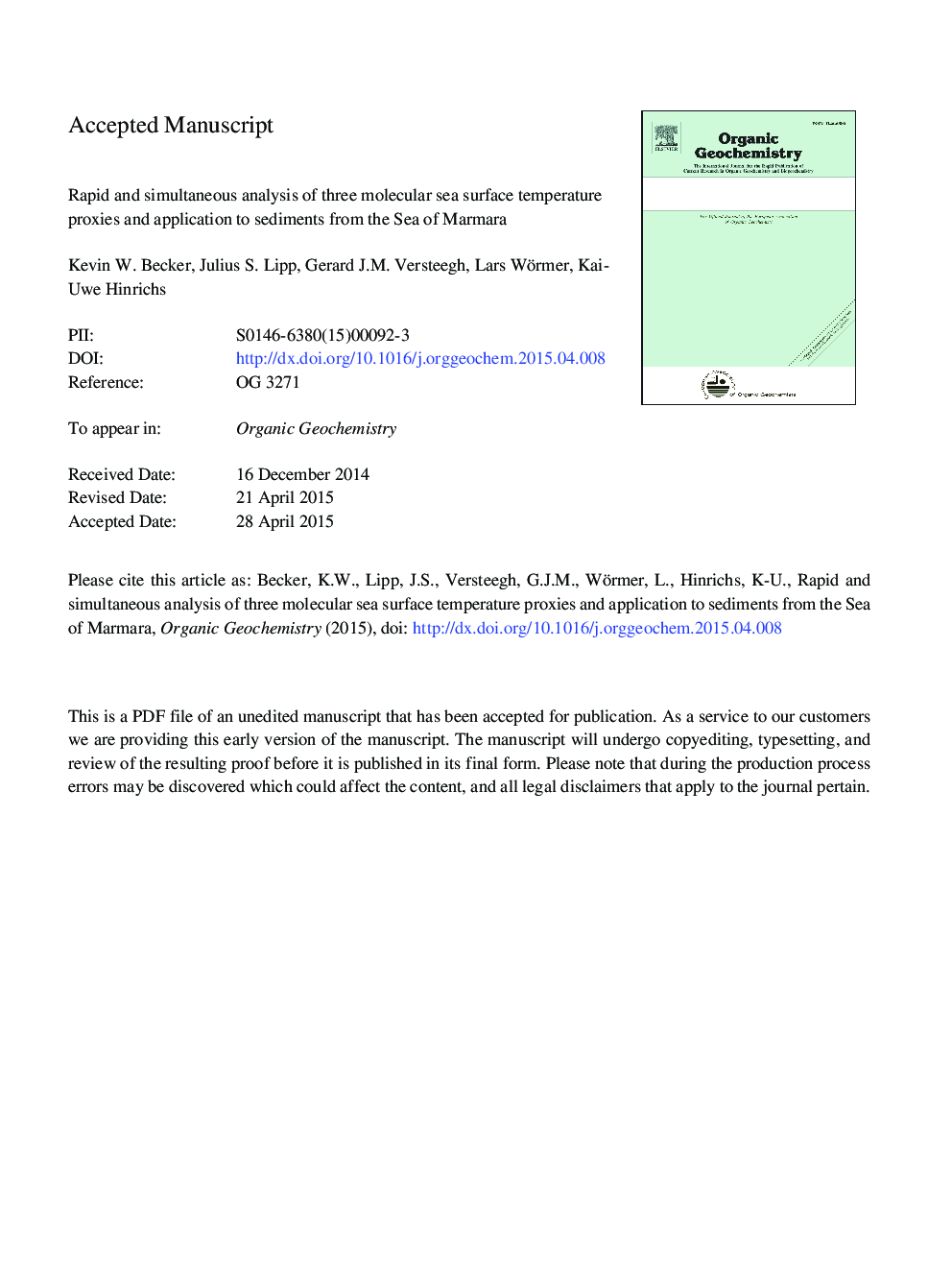| کد مقاله | کد نشریه | سال انتشار | مقاله انگلیسی | نسخه تمام متن |
|---|---|---|---|---|
| 5161523 | 1502277 | 2015 | 45 صفحه PDF | دانلود رایگان |
عنوان انگلیسی مقاله ISI
Rapid and simultaneous analysis of three molecular sea surface temperature proxies and application to sediments from the Sea of Marmara
ترجمه فارسی عنوان
تجزیه و تحلیل سریع و همزمان سه پروانه ی دما ی سطح دریایی مولکولی و کاربرد آن در رسوبات دریای مرمره
دانلود مقاله + سفارش ترجمه
دانلود مقاله ISI انگلیسی
رایگان برای ایرانیان
کلمات کلیدی
موضوعات مرتبط
مهندسی و علوم پایه
شیمی
شیمی آلی
چکیده انگلیسی
Reconstructing ocean temperature values is a major target in paleoceanography and climate research. However, most temperature proxies are organism-based and thus suffer from an “ecological bias”. Multiproxy approaches can potentially overcome this bias but typically require more investment in time and resources, while being susceptible to errors induced by sample preparation steps necessary before analysis. Three lipid-based temperature proxies are widely used: UKâ²37 (based on long chain alkenones from phytoplanktonic haptophytes), TEX86 [based on glycerol dialkyl glycerol tetraethers (GDGTs) from pelagic archaea] and LDI (based on long chain diols from phytoplanktonic eustigmatophytes). So far, separate analytical methods, including gas chromatography (GC) and liquid chromatography (LC), have been used to determine these proxies. Here we present a sensitive method for determining all three in a single normal phase high performance LC-atmospheric pressure chemical ionization mass spectrometry (NP-HPLC-APCI-MS) analysis. Each of the long chain alkenones and long chain diols was separated and unambiguously identified from the accurate masses and characteristic fragmentation during multiple stage MS analysis (MS2). Comparison of conventional GC and HPLC-MS methods showed similar results for UKâ²37 and LDI, respectively, using diverse environmental samples and an Emiliania huxleyi culture. Including the three sea surface temperature (SST) proxies; the NP-HPLC-APCI-MS method in fact allows simultaneous determination of nine paleoenvironmental proxies. The extent to which the ecology of the source organisms (ecological bias) influences lipid composition and thereby the reconstructed temperature values was demonstrated by applying the new method to a sediment core from the Sea of Marmara, covering the last 21 kyr BP. Reconstructed SST values differed considerably between the proxies for the Last Glacial Maximum (LGM) and the period of Sapropel S1 formation at ca. 10 kyr BP, whereas the trends during the late Holocene were similar. Changes in the composition of alkenone-producing species at the transition from the LGM to the Bølling/Allerød (B/A) were inferred from unreasonably high UKâ²37-derived SST values (ca. 20 °C) during the LGM. We ascribe discrepancies between the reconstructed temperature records during S1 deposition to habitat change, e.g. a different depth due to changes in nutrient availability.
ناشر
Database: Elsevier - ScienceDirect (ساینس دایرکت)
Journal: Organic Geochemistry - Volume 85, August 2015, Pages 42-53
Journal: Organic Geochemistry - Volume 85, August 2015, Pages 42-53
نویسندگان
Kevin W. Becker, Julius S. Lipp, Gerard J.M. Versteegh, Lars Wörmer, Kai-Uwe Hinrichs,
